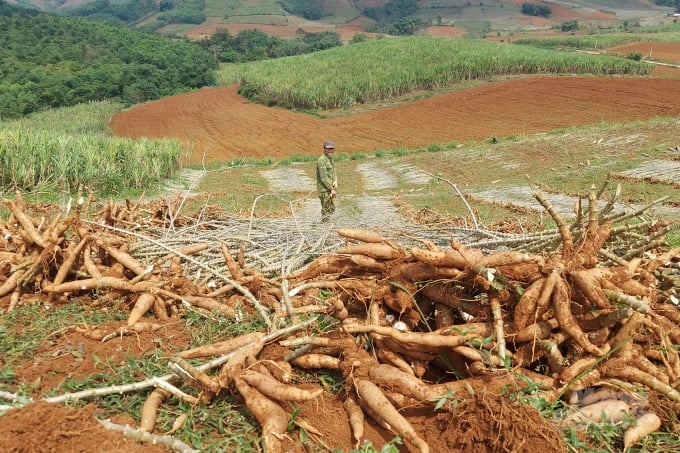November 25, 2025 | 22:11 GMT +7
November 25, 2025 | 22:11 GMT +7
Hotline: 0913.378.918
November 25, 2025 | 22:11 GMT +7
Hotline: 0913.378.918
Apart from difficulties such as loose linkages and unsustainable development, cassava mosaic disease (CMD) is a headache for cassava growers. Not only one locality but many key cassava farming areas of Vietnam are facing the same situation.

Deputy Minister of Agriculture and Rural Development Le Quoc Doanh during a visit to inspect the cassava mosaic disease situation in the South. Photo: PH.
Facing such a predicament, in 2021 the Ministry of Agriculture and Rural Development (MARD) introduced the first two cassava varieties that are resistant to cassava mosaic disease and are relatively adaptable to farming conditions in Vietnam.
New varieties that are more adaptive than these varieties are also being released. The Ministry of Agriculture and Rural Development, in cooperation with Tay Ninh Sub-Department of Plant Protection and provincial enterprises, has conducted a trial to propagate the most perfect cassava seeds.
According to Dr. Le Huy Ham, former Director of the Agricultural Genetics Institute (AGI - MARD), a number of measures to propagate disease-resistant cassava have been implemented such as the Tunnel propagation or tissue-culture propagation systems but all are not too feasible because it takes too long to wait, and the cost is too high. A good variety must meet the criteria of good health, high disease resistance but reasonable price to reduce the burden of cassava growers.
Dr. Le Huy Ham shared that a new variety has recently been found. It is 100% free of cassava mosaic disease, but the propagation takes place very slowly, causing many difficulties in farming. Farmers who want disease-free varieties must import from outside areas. If the same old variety is used next year, the disease will continue to return.
“Upon seeing people having to "swim on their own" and search for disease-free cassava varieties, agencies have created favorable conditions for Tay Ninh to develop a breeding center to respond to the needs of the people. However, the process needs more time. If we are fixated on applying Tunnel propagation or tissue-culture propagation systems, the price of cassava seeds will be very expensive.”

Dr. Le Huy Ham proposed a solution, which is to focus on producing disease-free cassava in the North then provide cuttings for provinces in the South. Photo: PH.
Dr. Le Huy Ham said that there is an easier solution at present - the solution of natural propagation: select disease-free cassava varieties for production and propagation in the North, then bring the cassava cuttings to the Central and South to serve production there.
The reason is that the North has a very cold winter. The long and severe cold at the beginning of this year, for example, will cause the whitefly (the vector that transmits cassava mosaic disease) to be destroyed, almost unable to make further development, so the spread of cassava mosaic disease in the North will be cut off and better controlled. Instead, the year-round warm sunshine in the South may sustain the existence of whitefly continuously.
This solution goes both ways as cassava growers in the North will also be assured because all seed sources put into production are disease-free varieties. After harvesting, raw cassava tubers will still meet normal requirements for factories, while cassava cuttings will be disease-free and abundant enough to both provide for local demands and supply for the southern provinces. This will be a "killing two birds with one stone" solution because the calculated propagation speed will be much faster, meeting the immediate production needs during the time waiting for the source of newly efficient and disease-resistant cassava varieties to be replicated for production.
Dr. Le Huy Ham also believed that this is a low-cost and easy-to-implement method. The Vietnam Cassava Association has gathered 70% of the country's cassava processing enterprises, so it is necessary to create regional linkages and have a coordination mechanism between production regions to facilitate cooperation between localities.
Cassava mosaic disease produces a variety of foliar symptoms that include mosaic, mottling, misshapen and twisted leaflets, and an overall reduction in size of leaves and plants. CMD-affected cassava plants produce few or no tubers depending on the severity of the disease and the age of the plant at the time of infection.
CMD has been causing great damage to the yield and quality of cassava in Vietnam and is now showing signs of increasing sharply in cassava growing localities. Up to now the whole country has recorded more than 63,000 ha of cassava affected by this disease.
Translated by Samuel Pham
/2025/11/24/3536-2-112800_176.jpg)
(VAN) Dong Nai now has tens of thousands of hectares of forests certified for sustainable management, and this area will continue to be expanded in the coming period.

(VAN) Vinh Ha hamlet (Dai Xuyen commune, Hanoi) is shifting away from small-scale farming as households adopt bioscurity into their breeder chicken models.

(VAN) Heavy rains make aquatic species more vulnerable to disease. Proactive water management and high-tech systems help farmers prevent outbreaks and protect yields.

(VAN) Greenhouses are shifting production mindsets in Binh Lu commune, enabling farmers to ‘weather the sun and rain’ and secure stable vegetable harvests throughout the year.

(VAN) Green transition is crucial for the Mekong Delta amid climate change and stricter standards, offering a path toward sustainability.

(VAN) Dong Thap promotes agricultural restructuring, forms large specialized farming zones, raises the value of agricultural products and develops toward ecological and high-tech directions.
/2025/11/22/4018-4-213342_747.jpg)
(VAN) The Mekong Delta Agricultural Experts Club has attracted 143 experts and researchers to participate in providing consultancy and contributing initiatives to the development of one million hectares of high-quality rice.